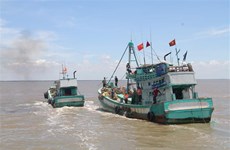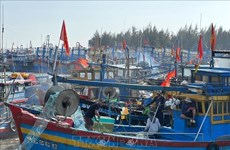Women’s role critical to eliminating rhino horn use
The role of women as providers and caretakers is pivotal to eliminating
the belief in and habit of using rhino horns as medication, said Do
Quang Tung, Director of the CITES Management Authority of Vietnam, on
March 13.
The role of women as providers and caretakers is pivotal to eliminating
the belief in and habit of using rhino horns as medication, said Do
Quang Tung, Director of the CITES Management Authority of Vietnam, on
March 13.
At a workshop held in northern Hai Phong port city, Tung underlined that profit from the global trading of elephant tusks and rhino horns reaches 15-20 billion USD a year, and Asia is the main consumer of both animal products. In recent years, Vietnam has become one of the world’s largest consumers of rhino horn.
Every year, the Hai Phong Customs Department seizes about 20 tonnes of rhino horns hailing from Africa and intended to be transported through Vietnam to other countries, he added, noting that growing poaching levels are pushing rhinos to the brink of extinction.
Teresa Telecky, Director of Wildlife for Humane Society International, highlighted that five rhino species exist in the world at present, including 275 Sumatra rhinos and 60 Java rhinos. The last rhino in Vietnam was killed for its horn in 2010.
The demand for rhino horn is based on the inaccurate belief that the powder can treat cancer and improve health conditions, she said, demonstrating scientific evidence that rhino horns have similar components to those of human fingernails and are completely unable to cure illness.
At the workshop, the CITES Management Authority also warned that rhino horns are usually injected with toxic chemicals to protect the animal from being poached. These poisons are not absorbed into rhino bodies but can cause adverse affects in horn consumers.
Meanwhile, a number of horns sold in the market are fraudulent and made of plastic, posing a significant risk to users, the authority noted.
Telecky suggested Vietnamese women communicate these important facts to their relatives to raise their awareness.
Taking affect from July 1, 1975, the Convention on International Trade in Endangered Species of Wild Fauna and Flora (CITES) was first signed in 1973 with the aim to protect certain wild species against over-exploitation through commercial trade. Vietnam joined the convention in 1994, becoming its 121 st member. As many as 180 countries have participated in CITES so far.-VNA
At a workshop held in northern Hai Phong port city, Tung underlined that profit from the global trading of elephant tusks and rhino horns reaches 15-20 billion USD a year, and Asia is the main consumer of both animal products. In recent years, Vietnam has become one of the world’s largest consumers of rhino horn.
Every year, the Hai Phong Customs Department seizes about 20 tonnes of rhino horns hailing from Africa and intended to be transported through Vietnam to other countries, he added, noting that growing poaching levels are pushing rhinos to the brink of extinction.
Teresa Telecky, Director of Wildlife for Humane Society International, highlighted that five rhino species exist in the world at present, including 275 Sumatra rhinos and 60 Java rhinos. The last rhino in Vietnam was killed for its horn in 2010.
The demand for rhino horn is based on the inaccurate belief that the powder can treat cancer and improve health conditions, she said, demonstrating scientific evidence that rhino horns have similar components to those of human fingernails and are completely unable to cure illness.
At the workshop, the CITES Management Authority also warned that rhino horns are usually injected with toxic chemicals to protect the animal from being poached. These poisons are not absorbed into rhino bodies but can cause adverse affects in horn consumers.
Meanwhile, a number of horns sold in the market are fraudulent and made of plastic, posing a significant risk to users, the authority noted.
Telecky suggested Vietnamese women communicate these important facts to their relatives to raise their awareness.
Taking affect from July 1, 1975, the Convention on International Trade in Endangered Species of Wild Fauna and Flora (CITES) was first signed in 1973 with the aim to protect certain wild species against over-exploitation through commercial trade. Vietnam joined the convention in 1994, becoming its 121 st member. As many as 180 countries have participated in CITES so far.-VNA













